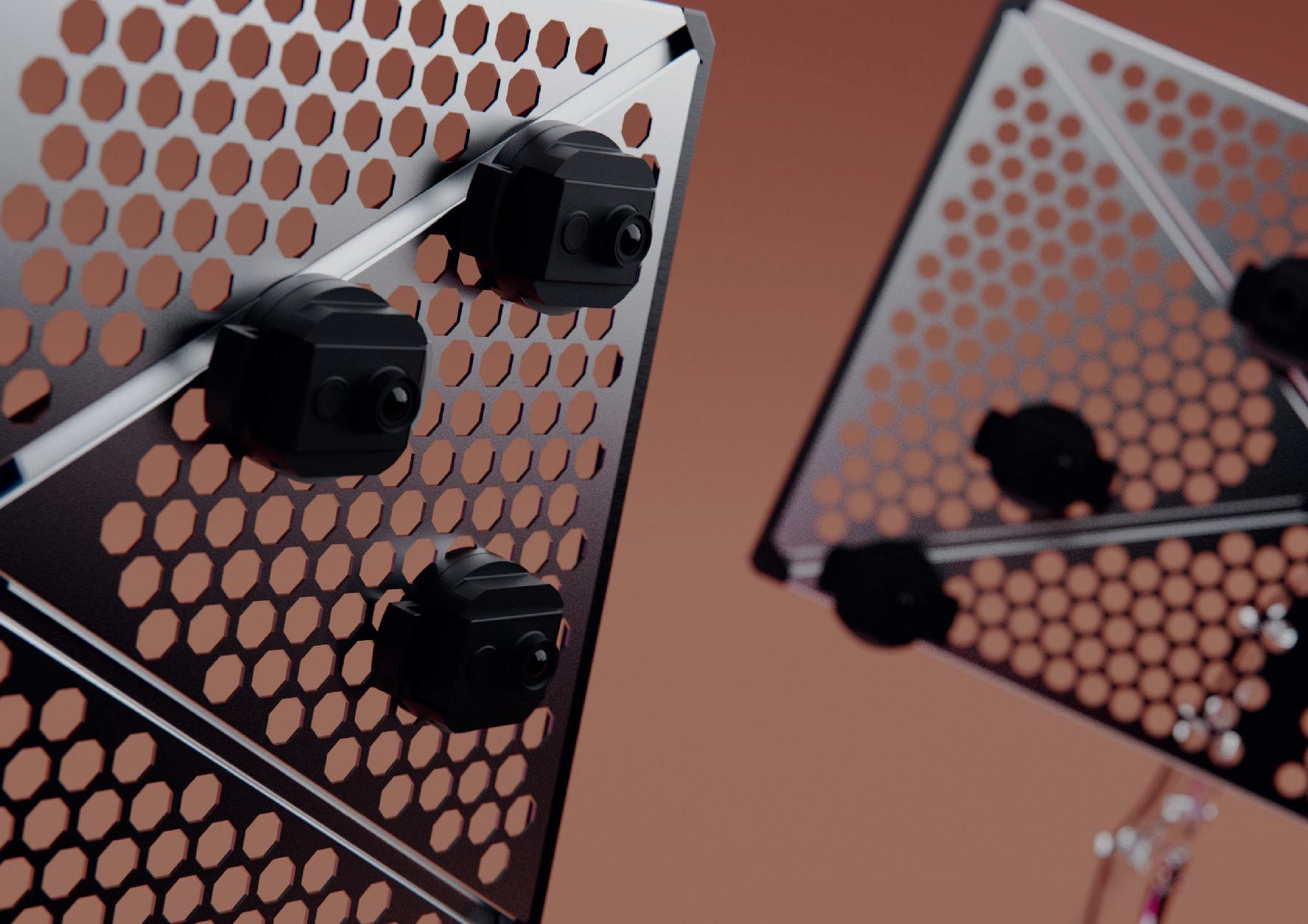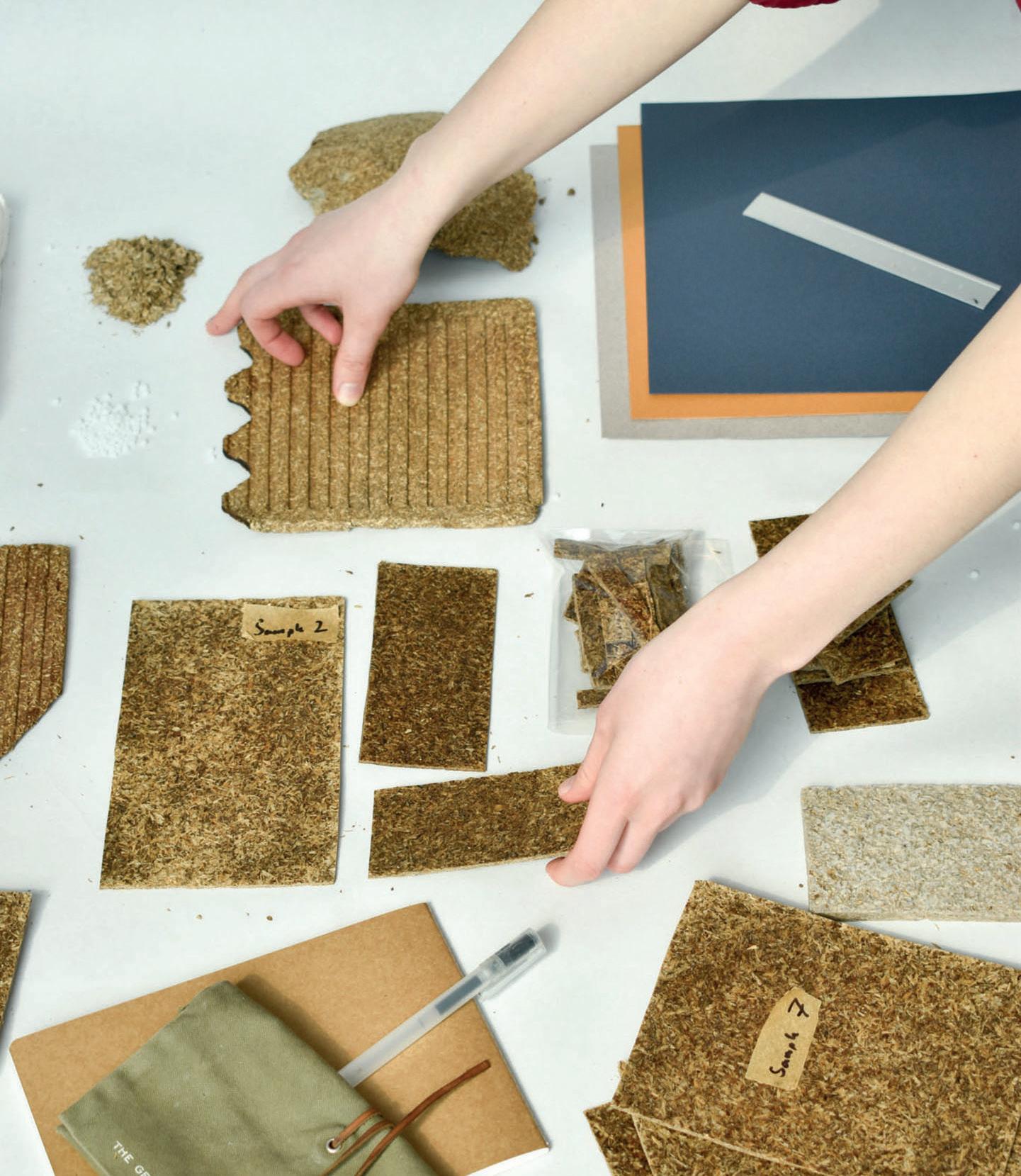
13 minute read
Finley Atterton Gabe Skeoch He Ng India Hay
Whilst studying Product Design Engineering I have developed a growing interest in materials, particularly regarding what they are made of and how they play an integral role in the ways in which we design, create, and interact with the world around us. Traditional practices teach that materials are merely interfaces to realise the functions of our designs. However, it is rarely considered possible to design the function into a material itself, in order to create something unique and wonderful.
Growing concerns over the state and future of our environment are highlighting the serious drawbacks of one of the world’s most widely used materials - plastic. The advanced properties of fossil-based plastics are less beneficial than we originally thought, allowing ‘disposable’ and toxic materials to outlast our lifetimes. Turning to nature for inspiration, we find alternatives and potential replacements to fossil-based plastics. Regenerative sources such as plants, animals, bacteria, and even our food waste, can contain key components to help tackle this problem.
Made From Beer is a production process that transforms brewer’s spent grain (a by-product of the brewing industry) and turns it into a mouldable and 100% biodegradable material that can be used to make truly disposable green products.
About 65%-78% of the spinal cord injury community experience spasticity, which is the uncontrolled tightening or contracting of the muscles. It causes extreme discomfort, severely impacting the lives of those affected. The most effective way to reduce spasms is to stretch the muscles regularly, however it is extremely difficult to do that without control of the legs. Thorough research into user’s current stretching routines found that there were no similar products on the market for independent stretching.
The Stretch Assistant is a portable, mechanical leg brace that helps paraplegics safely and independently stretch their legs. The device is designed to slide on from the front of the users leg, while they are sat in their wheelchair, and is operated in the same manner for either leg. The use of a ratchet strap, pulling a short lever, connected to the lower leg frame, provides the appropriate advantage to allow the user to lift their leg, and hold it in place. The device allows for 14 various angles of extension, for users with varying flexibilities, and has straps that allow the user to pull their foot towards them, and their upper body forwards, to intensify the stretch. The device would come in 3 sizes, each with a range of adjustability for maximum comfort, and design details ensure safe and easy operation.
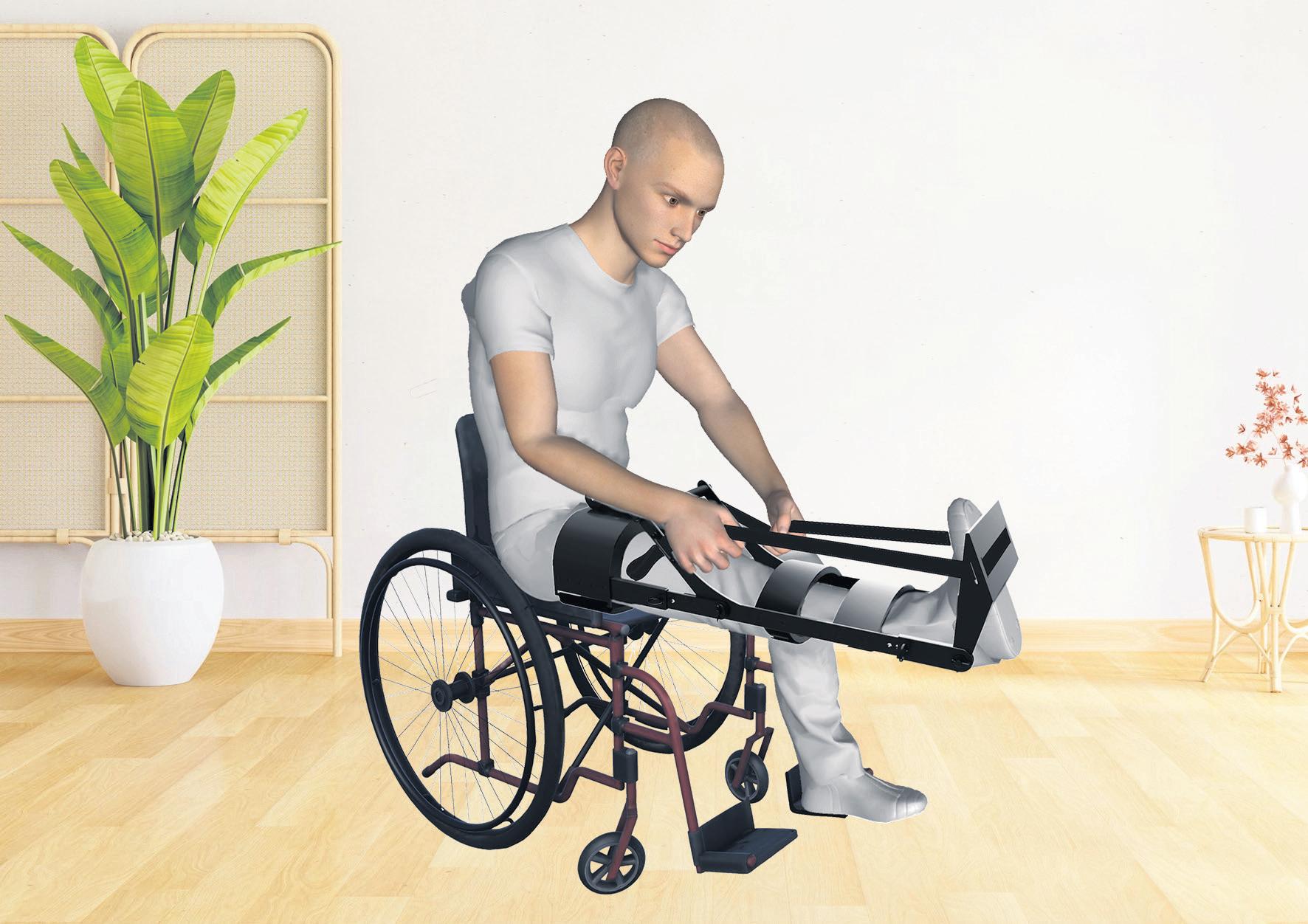
Hi, my name is He.
am an extravagant person. love doing big display, and showing off what could do as much as possible. enjoy different challenges and exploring uncharted territory. The area have chose to tackle within this year’s project is sewing. Other skill which also possess are: kitchen, instruments, interior design… am a product design engineer with a passion for user-centred medical industrial design. am particularly interested in using colour and form to make medical products more appealing and intuitive for the patient to use. This year my work has focused on wearable bio sensors, and I have enjoyed using CAD surfacing techniques, foam modelling, 3D printing and graphic design techniques to develop my final product, REM Track. am a Product Design Engineer whose practise revolves around iterative testing and making. My design process is defined through collaborations with stakeholders, and their feedback on prototypes and models is used to optimise and improve designs. am an Irish designer with an eagerness to learn as much as possible about the world around me and apply it to my work. am very hands-on and love to challenge myself within different areas of design to tackle problems through physical and mechanical means. My focus is on sustainability through quality and longevity in design. like to solve problems with real solutions and create user centred, long lasting products that make a tangible and necessary difference to people’s lives. I have applied this ethos to my design of a stackable, changeable drum kit this year.

Sewing was quite a fun thing to learn. The world of textile design is completely different to what I have known, and I am glad I was able to get a glimpse of it this year. This project had helped me understand what is it am wearing every day, and different ways our everyday clothing could be improved. It had also helped me see the inherit properties of textile, and how other product could benefit with a touch of textile. Like what they did with Google home. This is the fun thing about designing, the skill which possess are so transferable. Rapid research, prototype and general design helps me get up to speed in every area. Being able to work out of my comfort zone is definitely hard, but also something that I had came to enjoy.
What makes a theme park experience meaningful is whether it means something to you. Not only narratively, musically, visually, emotionally, but physically. Tactilely. Powerful experiences require powerful sensation.
TacTILE uses low-frequency vibration for floor-based sensation in theme parks. Whether it’s the rumble of a spaceship engine, the earth-shaking footsteps of a dinosaur, or the power of a supernatural force, TacTILE makes the magic real.
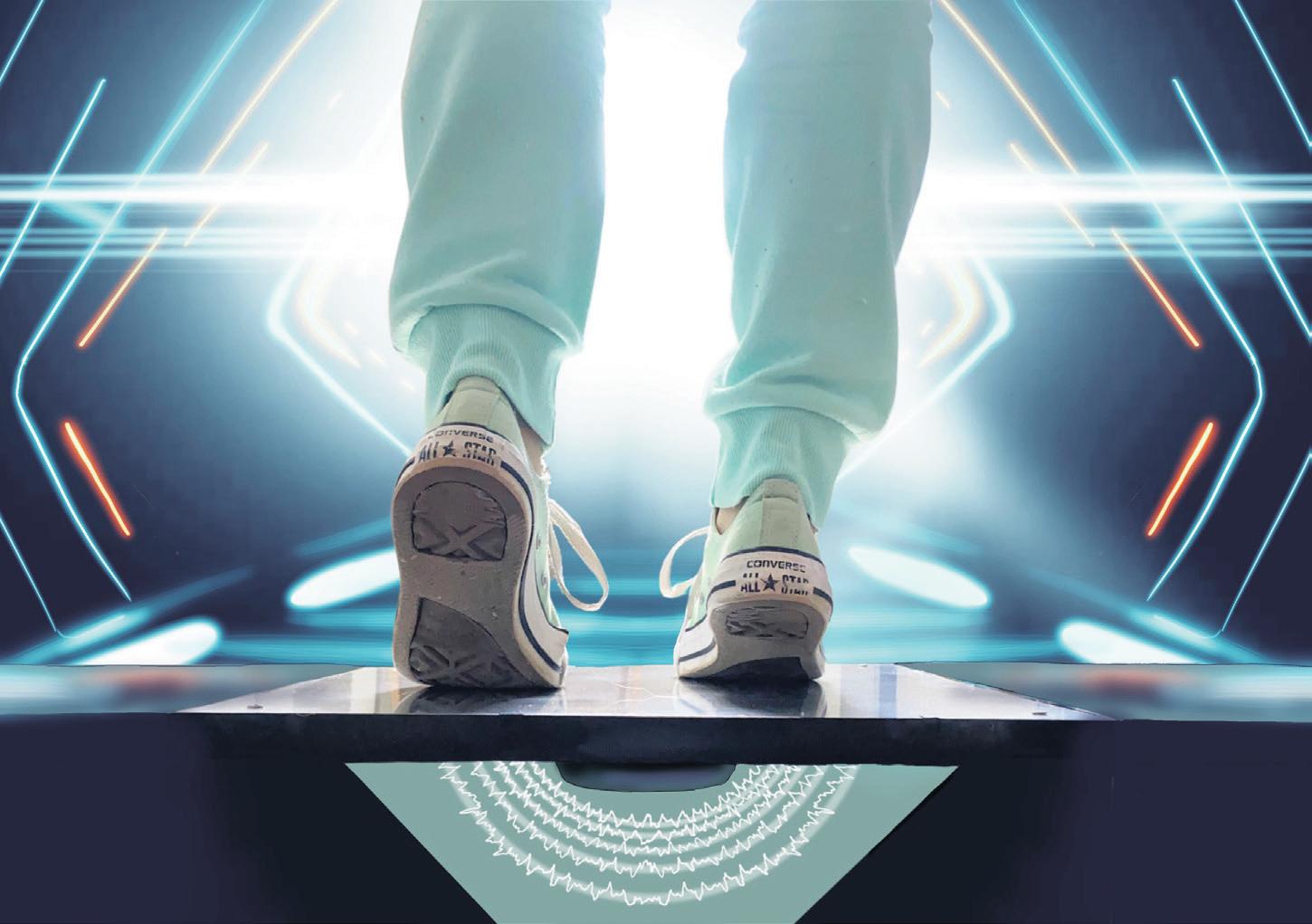
Its modular tile system is fully scalable, so no matter how big the attraction, TacTILE has it covered. The vibrotactile sensation is customisable across each individual tile, so theme park designers can finetune an experience for maximum immersivity.
Inspired by raised access flooring, TacTILE is compliant with the UK and USA’s raised floor safety regulations regarding load capacity. This, plus its simple electronics and straightforward installation, sets it apart from other haptic flooring solutions.
India is an aspiring theme park designer and engineer. When not studying, she writes and publishes articles about what themed entertainment means to the human experience.
My MEng project documents the design of an at-home diagnostic tool for narcolepsy. The design problem identified was that the electroencephalography (EEG) system for measuring brain activity during polysomnography (PSG) overnight sleep testing is cumbersome, uncomfortable, and time consuming to set up. I was interested in exploring the concept of a ‘reduced EEG system’ that is compact, wearable, and uses a small number of channels to test for specific neurological conditions.
Using key insights from the neurology and sleep departments at the Glasgow Queen Elizabeth and Edinburgh Royal Infirmary hospitals, designed an overnight home sleep test device for narcolepsy detection. Technical results were used to decide on the most appropriate electrode configuration, key electronic components, and a suitable material. REM Track is worn around the head, and electrode leads are connected according to a colour coded system in the instructions for use (IFU).
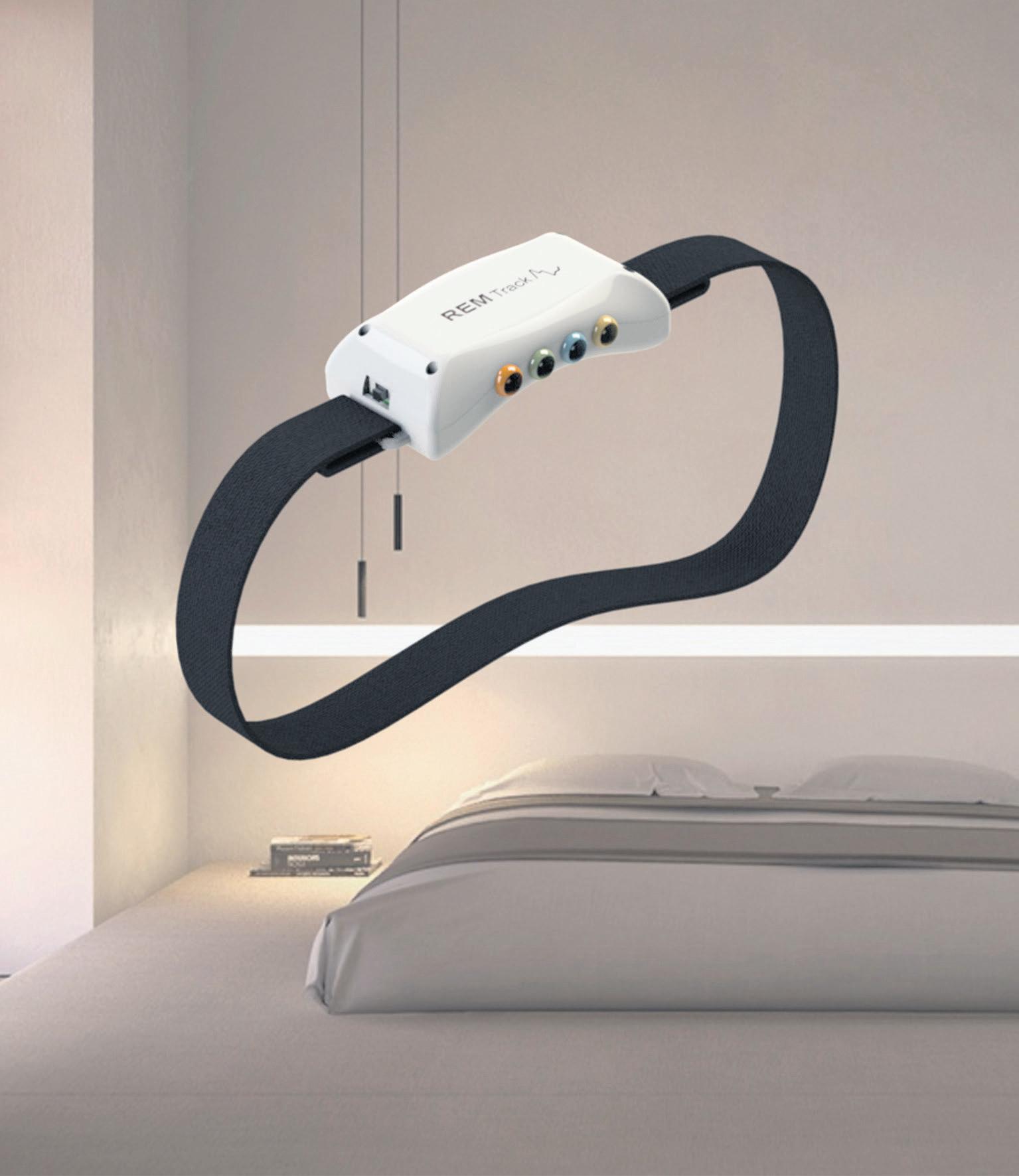
I am a Product Design Engineer with a strong focus on inclusive and accessible design. I strongly value including comprehensive user feedback into my design process, to effectively incorporate elements human factors and understand the behaviours and characteristics of key users.
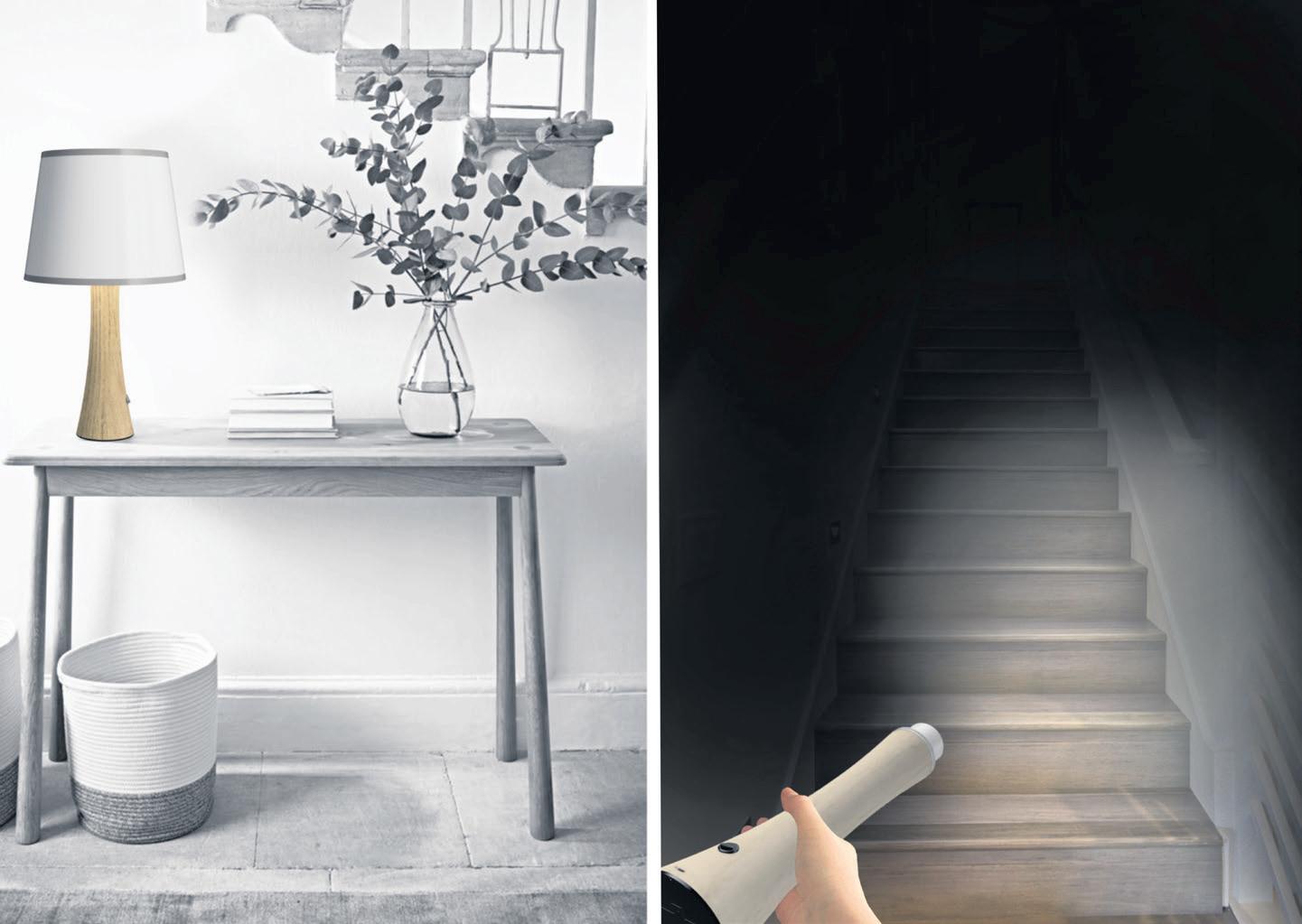
After working with the Female Engineering Society throughout my time at university, diversity has become a key focus which I prioritise within my work. strive to create products which meet the needs of diverse users and challenge traditional biases. This passion towards inclusivity extends to users with physical and mental impairments, and, as someone who has suffered from eyesight issues personally, have made this the focus of my final year project.
InSight is a product which aims to improve the communication between optometrists and their patients by displaying a 3D representation of the patient’s retina, whilst simultaneously showing how their vision may progress in future. This aids the patients understanding of their condition, which can reduce the negative emotional impact that vision loss can have on the individual. The product utilises dome projection technology controlled by a touch-screen device which can be used to store the patients scan and display the simulation of their vision.

As a product design engineer, my practice involves the ideation, design, and development of products from concept to production. My aim is to utilise my knowledge of materials, manufacturing processes, and user-centred design principles to deliver functional and visually appealing products that meet the needs of the target market. Ultimately, my goal is to create products that enhance the user experience and make a positive impact on people’s lives. For my final year project, I have been designing a Universal Stretcher Wheel Unit for UK Mountain Rescue teams. The wheel unit is compatible with the four main stretcher models used in the UK, making it a versatile addition to any team’s rescue equipment. Featuring a quick release Isofix mechanism, teams can easily attach and detach the stretcher wheel unit to any of their stretchers in seconds, without the need for any additional tools. The stretcher wheel unit has a robust frame made from high-quality aluminium 6061, making it lightweight and durable, perfect for use in mountain rescue scenarios. It also features a wide 26x4.0” bike tyre that can easily travel over all terrain, ensuring teams can descent quickly and efficiently, whether they’re dealing with rocky mountain paths or soft snow.
I am a product design engineer from Glasgow, who loves all things design and technology. I have a passion for creating solutions to everyday problems and love to talk to people to hear their needs as well as finding flaws within products today. By using both my design and engineering skills, I can create solutions that suit people’s needs, not only aesthetically but with the necessary technology to go along with it. For my final year project, I have been looking into a more reliable lighting solution for the use during power outages.Through investigations, I found a lot of the elderly feel very vulnerable during power cuts, with them worrying about falling around their home in the dark. That’s why created The Genie LED, a rechargeable table lamp with two functions. A simple solution which acts as a normal table lamp throughout the day but as soon as the power goes off, The Genie has an automatic illumination of an LED, that will never leave you in darkness again or scrambling around for a torch! It simply allows the user to gather their bearings as they are not flung into darkness, walk over to the illuminated lamp, remove the shade, unplug, and use as a portable device around the home for up to nine hours.

Creative, child-led, outdoor play has seen a massive decrease in popularity. In response to this, schools and other organisations are introducing loose parts play, an activity where children can build and shape their environment using repurposed parts.

The Big Clamp system introduces fun and exciting possibilities to this type or play. The set consists of three variants, Big Clamp, which provides an easy and robust method to combine and secure parts. Big Wheel, which supports the creation of cars and moving platforms, and Big Hinge, which can be used to build stable structures or add dynamic elements to a design.

As a product design student, am passionate about exploring different fields and breaking down the barriers between different design disciplines. When it comes to aesthetics, I prioritize not only the functional aspects of a product but also the way it looks and feels. I believe that a product should evoke a sense of warmth and fun for the user, and I strive to create designs that convey those qualities.
Furthermore, am committed to designing products that can benefit marginalized communities. hope to use my skills and creativity to address the unique needs of these groups and make a positive impact on their lives. I am excited about collaborating with people from different backgrounds and disciplines to apply my designs to various fields and meet the needs of a wider audience.
During my final year of study, I designed a silicone breathing rabbit lamp specifically for children with autism between the ages of 3 and 6. The lamp features a rubber bulb on the rabbit’s tail that can be squeezed to inflate and deflate the lamp, mimicking the rhythm of breathing. It also comes with lampshades made of various materials to accommodate the sensory preferences of children. This lamp is designed to help anxious children calm down through slow, rhythmic breathing, while also improving their attention and coordination.


The WeeGuard was developed in collaboration with Forest Research to address the issue of pine weevil damage in saplings. Pine weevils are a significant pest in forestry and their management costs the Scottish forestry industry £40 million annually. The WeeGuard provides a physical barrier solution to replace the need for pesticides. Repeated testing with pine weevils allowed an optimal pine weevil stopping form to be defined. To ensure that the barrier would be easily applied to hundreds of saplings at a time, various opening methods were explored and tested. The application method was chosen and refined through iterative testing with tree planters to ensure that the final product met the needs of the industry. Current development in the field of biodegradable materials also heavily influenced the design process and design for manufacture. WeeGuard is designed with future materials in mind and will be functional with range of material properties.
My work focuses on design for genuine circularity, and using innovation to drive a circular economy. Product design engineering involves combining creative design and concept development with technical skills to ensure realistic and verified concepts. I am passionate about using these skills to genuinely improve lives by solving societal problems. My final project at GSA, “BALED”, is a concept for driving up the financial value of waste films & flexible plastics by making it easier for businesses to collect and recycle them. A literature review established key insights into plastic waste. Soft plastics are not economically viable to recycle due to their large volume and relatively low value and weight. Beyond research, meetings were undertaken with experts in the sector to garner further insights. A variety of potential mechanisms for compacting and constraining the material were devised and tested. Driving a commercial incentive for sustainability is vital to ensure that businesses are ready and willing to change, and I believe design engineering has an important part to play in this journey. Beyond research and development, I undertook digital modelling and physical prototyping to verify my final designs. The manual compaction mechanism is simple and cheap so that the design could be applied anywhere on the planet to drive better waste management.
This project proposes to the client the potential of Ambient Aperture Technology (AAT) for In-Ear Monitors (IEMs), used on stage by musicians during performances and sound checks. Compared to wedge monitors, IEMs allow reduced feedback and stage noise, more control over the user’s personal mix and, overall, an improved relationship between a musician and their music.

Despite semi-professional musicians looking to use IEMs, the project identifies the gap in the market for a product that meets the needs of these musicians. The environment in smaller venues in which semi-professional musicians perform imposes different requirements for the product which are currently not catered for in the market. Research proves that a leading problem experienced by the target market of semi-professional musicians is the isolation felt from ambient noise in the environment being blocked whilst wearing IEMs.
The project presents the need for the proposed solution: an IEM headset containing the unique AAT, which provides a method for users to control the amount of ambient noise passing into their ear canal. AAT eliminates the feeling of isolation experienced in the operational environment. The solution presented to the client allows musicians to take back control of their performance experience and engage with fans and fellow band members.
I am a designer who is an advocate of inclusive design, and this influenced my final year product design engineering project. The ability for older people to be able to perform the Sit to Stand motion is important for their general health and wellbeing, as well as for promoting independence.
Unfortunately, as people get older their muscle strength deteriorates, while degenerative conditions such as arthritis and Parkinson’s disease which limit mobility and muscle control become more prevalent. This in turn can negatively impact on their ability to perform the sit to stand motion. ‘Boost Buddy’ is a lightweight, portable sit to stand assist device which aids users to achieve the sit to stand motion. It is made up of a casing which acts as two hinged plates. An inflatable component is placed between these plates and inflates to force the plates apart. This causes the upper plate to pivot around its axis and raise the user steadily to 45. The device employs small, compressed CO2 cartridges to inflate the design. The inflation is controlled by the user with an easy-to-use controller with an up and a down button. The product comes complete with a comfortable fabric covered foam cushion, which can be easily removed for washing, and a carry handle to allow for easy carrying.
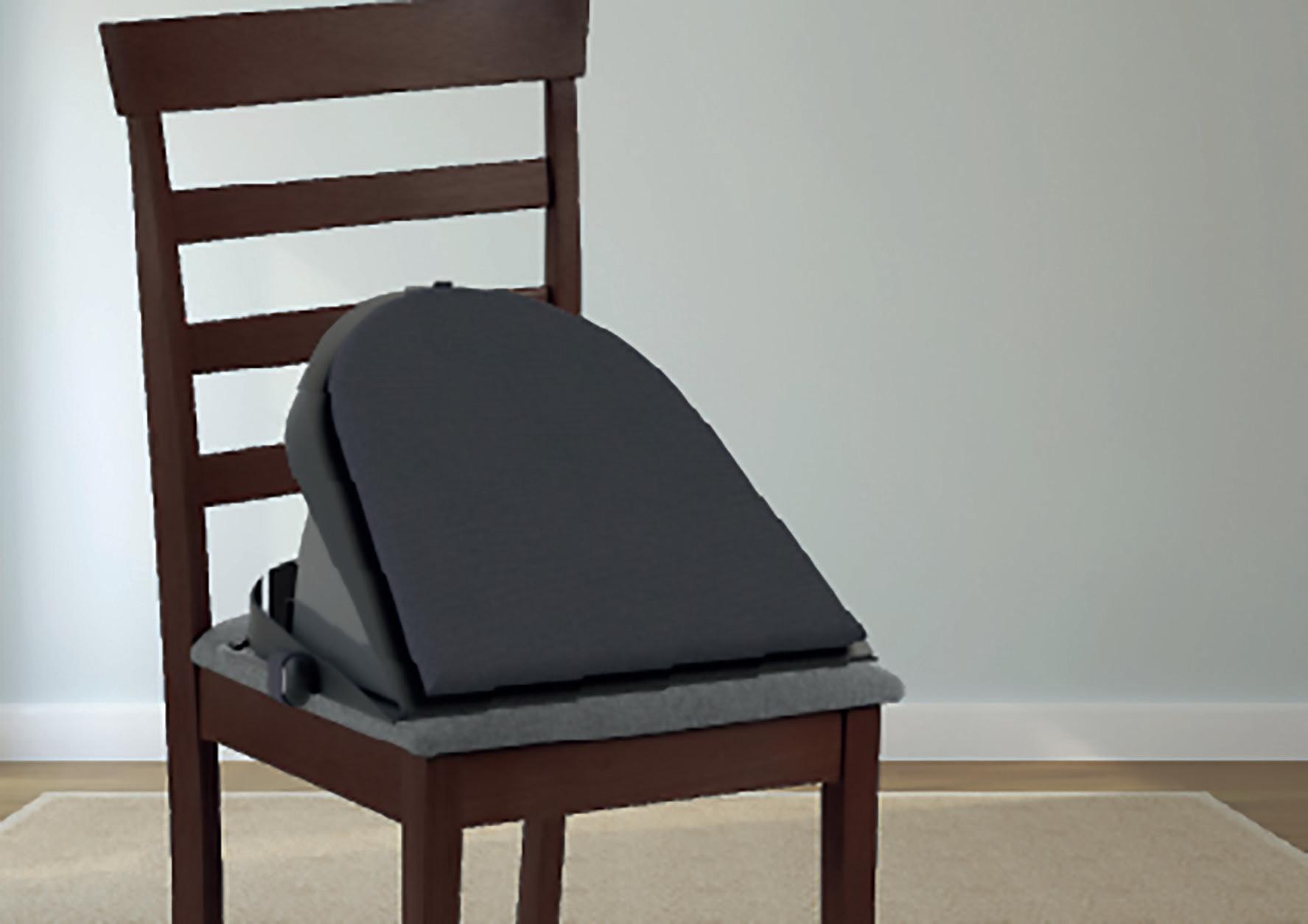
Drum kit design has stagnated in functionality for many years, but this product can revolutionise the market. Contemporary kits take up a considerable amount of room when not in use, they are loud, difficult to transport and expensive. Many percussionists who live in small spaces struggle to co-exist with their instrument. The Space Between kit revamps drum hardware design, displacing the drums’ fixed tuning mechanism to an external frame. This frame can be separated using simple latches, allowing the drum shell and head to be removed. This allows the drum kit to stack within itself for a 60% reduction in volume. The drummer can also access the drum heads with ease, allowing them to swap between practise, electronic and performance heads in less than a minute.

Oura is the world’s first, and only, dedicated Dynamic Neural radiance field camera system.
Designed to give product-videographers the opportunity to create moving, volumetric 3D scenes, and animate camera motion in post-production. This Process allows the videographer to create perfectly timed, stable, repeatable and editable camera paths. By replacing the complex and expensive mechanics of robotic motion systems with a static, AI driven product, Oura comes in at 5% of the cost.
Rather than moving a single camera around a subject, Oura consists of 3 panels, mounted on tripods, onto which a total of 18 camera modules can be attached to build an endlessly reconfigurable number of ‘bullet-time’ arcs. These cameras, operated via the users-phone, capture the scene from a variety of angles at once, and the in-sync-videos from across the rig are fed into a Neural network that teaches itself to recreate the scene in 3D, using the same ray tracing process seen in video-games.
This 3D reconstruction known as a D-NeRF, allows the user to implement unconstrained and dynamic virtual-camera-motion into their work that can be edited and adjusted in both it’s timing and movement to cut down the feed-back loop with their client.
